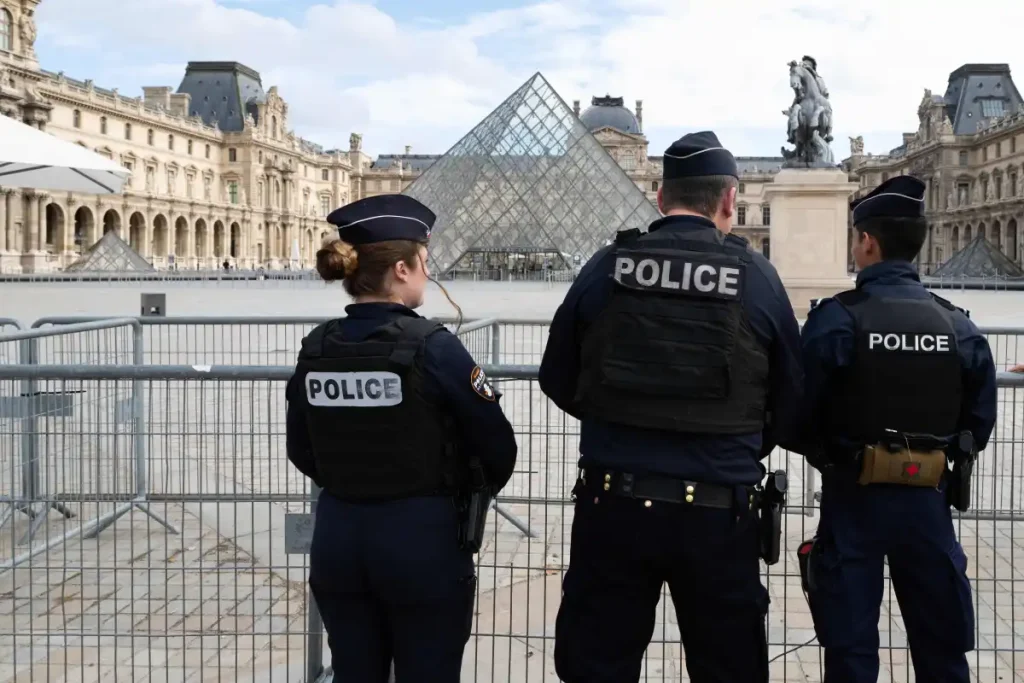Swift Arrests Follow Audacious Louvre Jewelry Heist
In a dramatic development following last week’s shocking daylight robbery at the Louvre Museum in Paris, two men have been apprehended by French judicial police in connection with the brazen theft of historic jewelry valued at an astounding $102 million. According to reports from the French newspaper Le Parisien, the arrests occurred on Saturday evening, marking a significant breakthrough in what has quickly become one of the most high-profile art heists in recent memory. One suspect was reportedly captured at Paris Charles de Gaulle Airport while attempting to board a flight to Algeria, suggesting the perpetrators had planned a swift international escape route following their audacious crime.
The original heist, which lasted a mere seven minutes, forced the world’s most visited museum into an unexpected lockdown as visitors and staff alike found themselves in the midst of what seemed like a scene from a Hollywood thriller. The efficiency and boldness with which the thieves executed their plan sent shockwaves through the international art community and raised serious questions about security measures at one of the world’s most prestigious cultural institutions. According to investigators, the operation appears to have been meticulously planned, with the criminals exploiting vulnerabilities in the museum’s security protocols during peak visiting hours when the galleries were filled with unsuspecting tourists.
The authorities believe that the two men in custody were part of a larger group of four criminals who coordinated the sophisticated theft. The jewelry pieces taken during the heist represent not only extraordinary monetary value but also irreplaceable historical significance, making their recovery a top priority for French authorities. The targeting of such high-value historical artifacts suggests the involvement of experienced criminals who likely had connections to black market art dealers willing to purchase such recognizable pieces despite their notoriety following the theft.
What makes this case particularly alarming for security experts is the thieves’ ability to enter and exit one of the world’s most heavily guarded museums with such valuable items in broad daylight. The Louvre, which houses priceless treasures including the Mona Lisa, has sophisticated security systems including cameras, motion detectors, and armed guards. That the thieves were able to circumvent these measures in such a short time frame points to either inside knowledge of the museum’s security protocols or extraordinary criminal expertise. The successful execution of the heist has prompted calls for a comprehensive review of security measures at major museums worldwide.
The swift arrests represent an impressive response from French law enforcement, who mobilized significant resources to track down the suspects before they could potentially disappear across international borders. The capture of one suspect at the airport highlights the critical importance of coordination between different branches of law enforcement in responding to major crimes. According to unofficial sources close to the investigation, authorities are now racing to locate the remaining suspects and, more importantly, recover the stolen jewelry before it can be broken down, sold, or otherwise disappear into the shadowy world of illegal art trafficking.
As this developing story unfolds, museum officials, art experts, and security specialists around the world are watching closely, recognizing that the outcome will likely influence future approaches to protecting invaluable cultural treasures. The Louvre heist serves as a sobering reminder of the ongoing challenges faced by institutions tasked with both displaying priceless artifacts for public appreciation while simultaneously ensuring their security. While investigators continue their work to apprehend the remaining suspects and recover the stolen items, the museum community is already engaged in serious discussions about how to prevent similar incidents in the future without compromising the public’s access to humanity’s greatest artistic achievements.


